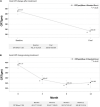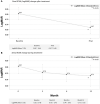Optical Coherence Tomography Biomarkers in Predicting Treatment Outcomes of Diabetic Macular Edema After Dexamethasone Implants
- PMID: 35755055
- PMCID: PMC9218219
- DOI: 10.3389/fmed.2022.852022
Optical Coherence Tomography Biomarkers in Predicting Treatment Outcomes of Diabetic Macular Edema After Dexamethasone Implants
Abstract
Purpose: To identify optical coherence tomography (OCT) biomarkers that may predict functional and anatomical outcomes in diabetic macular edema (DME) patients treated with intravitreal dexamethasone (DEX) implant.
Materials and methods: Sixty-four eyes from 50 patients with DME were enrolled. Best-corrected visual acuity (BCVA) and OCT biomarkers including central retinal thickness (CRT), subretinal fluid (SRF), intraretinal cysts (IRC), ellipsoid zone disruption (EZD), disorganization of retinal inner layers (DRIL), hard exudate (HE), hyperreflective foci (HRF), epiretinal membrane (ERM), and vitreomacular interface (VMI) changes were evaluated at baseline and at 3, 6, and 12 months after treatment. Multiple logistic analysis was performed to evaluate each OCT biomarker as a predictive factor for functional and anatomical improvement at the end of treatment.
Results: The presence of SRF at baseline was associated with a favorable outcome, with CRT improving by more than 100 μm after treatment from multivariate logistic regression analysis [odds ratio 6.16 (1.75-21.6)]. In addition, baseline SRF predicted a greater CRT improvement from multiple regression analysis (model R-square 0.11, p = 0.006). The reduction of DRIL, SRF, LONLC, IRC, and EZD were correlated with better CRT improvement (more than 100 μm) (P < 0.05). SRF and EZD recovery can also predict better visual prognosis (P < 0.05).
Conclusion: OCT biomarkers can be used to predict who may benefit the most after DEX treatment. We suggest that the DEX implant should be considered as a first line treatment in DME patients with SRF.
Keywords: diabetic macular edema (DME); disorganization of retinal inner layers; hyperreflective foci; intravitreal dexamethasone implant; optical coherence tomography biomarkers; subretinal fluid.
Copyright © 2022 Huang, Chang, Meng, Lin, Lai, Hsia, Chen, Tien, Bair, Lin, Chen and Tsai.
Conflict of interest statement
H-SC was employed by NephroCare Ltd. The remaining authors declare that the research was conducted in the absence of any commercial or financial relationships that could be construed as a potential conflict of interest.
Figures





Similar articles
-
Optical Coherence Tomography Biomarkers in Predicting Treatment Outcomes of Diabetic Macular Edema after Ranibizumab Injections.Medicina (Kaunas). 2023 Mar 21;59(3):629. doi: 10.3390/medicina59030629. Medicina (Kaunas). 2023. PMID: 36984630 Free PMC article.
-
Optical coherence tomography biomarkers in patients with macular edema secondary to retinal vein occlusion treated with dexamethasone implant.BMC Ophthalmol. 2022 Apr 26;22(1):191. doi: 10.1186/s12886-022-02415-w. BMC Ophthalmol. 2022. PMID: 35473615 Free PMC article.
-
OCT Biomarkers as Functional Outcome Predictors in Diabetic Macular Edema Treated with Dexamethasone Implant.Ophthalmology. 2018 Feb;125(2):267-275. doi: 10.1016/j.ophtha.2017.08.031. Epub 2017 Sep 19. Ophthalmology. 2018. PMID: 28935399
-
Predictive impact of optical coherence tomography biomarkers in anti-vascular endothelial growth factor resistant macular edema treated with dexamethasone implant.Photodiagnosis Photodyn Ther. 2023 Jun;42:103167. doi: 10.1016/j.pdpdt.2022.103167. Epub 2022 Oct 17. Photodiagnosis Photodyn Ther. 2023. PMID: 36261095
-
Anatomic biomarkers as potential endpoints in diabetic macular edema: A systematic literature review with identification of macular volume as a key surrogate for visual acuity.Surv Ophthalmol. 2025 May 1:S0039-6257(25)00069-4. doi: 10.1016/j.survophthal.2025.04.004. Online ahead of print. Surv Ophthalmol. 2025. PMID: 40318769 Review.
Cited by
-
Optical Coherence Tomography Reflectivity in Foveal Cysts: A Novel Biomarker for Early-Response Prediction of Diabetic Macular Edema Treated with Dexamethasone.Life (Basel). 2022 Sep 23;12(10):1475. doi: 10.3390/life12101475. Life (Basel). 2022. PMID: 36294910 Free PMC article.
-
Intraretinal Hyper-Reflective Foci Are Almost Universally Present and Co-Localize With Intraretinal Fluid in Diabetic Macular Edema.Invest Ophthalmol Vis Sci. 2024 May 1;65(5):26. doi: 10.1167/iovs.65.5.26. Invest Ophthalmol Vis Sci. 2024. PMID: 38758639 Free PMC article.
-
A machine learning model for predicting anatomical response to Anti-VEGF therapy in diabetic macular edema.Front Cell Dev Biol. 2025 May 30;13:1603958. doi: 10.3389/fcell.2025.1603958. eCollection 2025. Front Cell Dev Biol. 2025. PMID: 40519258 Free PMC article.
-
Response to: Optical coherence tomography biomarkers in preterm infants with and without retinopathy of prematurity: fallacies and facts.Eye (Lond). 2024 Sep;38(13):2658-2660. doi: 10.1038/s41433-024-03062-9. Epub 2024 May 6. Eye (Lond). 2024. PMID: 38710938 No abstract available.
-
Guidelines from an expert panel for the management of diabetic macular edema in the Malaysian population.Int J Ophthalmol. 2023 May 18;16(5):712-720. doi: 10.18240/ijo.2023.05.07. eCollection 2023. Int J Ophthalmol. 2023. PMID: 37206185 Free PMC article.
References
-
- International Diabetes Federation. IDF Diabetes Atlas. 8th ed. Brussels: International Diabetes Federation; (2017).
LinkOut - more resources
Full Text Sources
Research Materials
Miscellaneous

